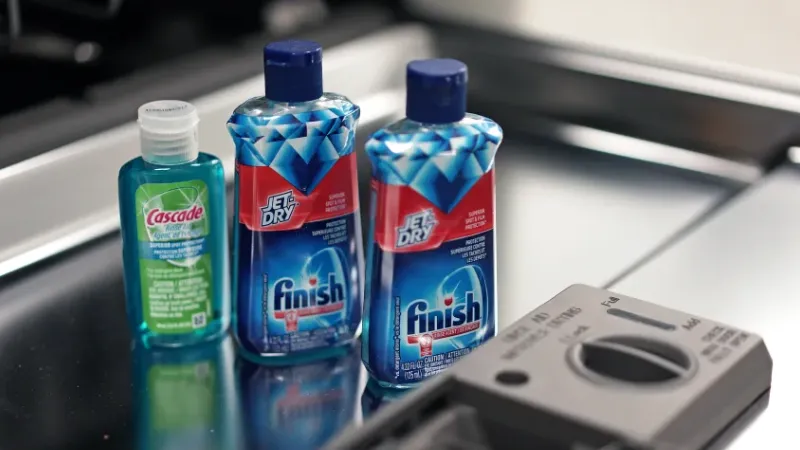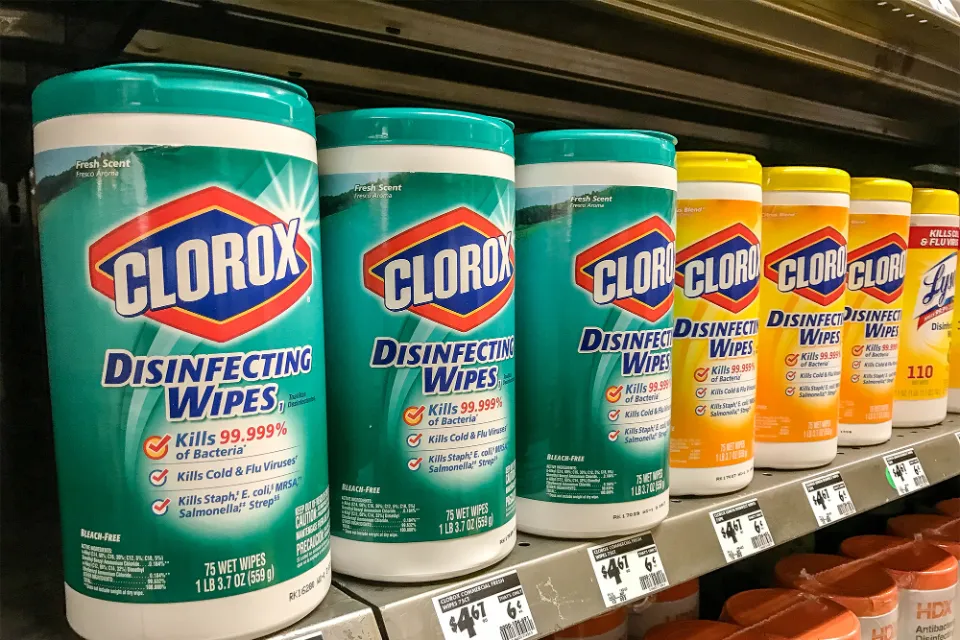What is dishwasher rinse aid? You should incorporate rinse aid into your regular dishwasher routine if you want to make sure that every load of dishes you run through the dishwasher is finished with perfect cleanliness and no streaks.
The dishwasher rinse aid is designed to help you get spotless results from your machine. It speeds up drying and prevents etching on your glassware. Today, rinse aid has its own specific dispenser in almost all modern dishwashers.
Please read on.
What is Rinse Aid?
In short, rinse aid is a surfactant that lowers the surface tension of water.1 Surface tension is the “skin” effect on a droplet that makes it ball up rather than spread out on a surface. (A leaf covered in water drops is an example.) Rinse aid functions as a surfactant, preventing water from condensing into droplets and promoting thin sheets of water to drain from the surface. As a result, spots from dissolved minerals left behind by evaporated droplets are lessened. Rinse aid doesn’t actually speed up the rinsing process; instead, it zaps water droplets to speed drying and enhance shine. But what sort of sorcery is behind this magic? Things start to become a little shaky at that point, if you will.
benefits of dishwasher rinse aid:
- Absolutely sparkling dishes, particularly glasses
- Enhanced and more effective drying
Protection for glassware against etching and marks
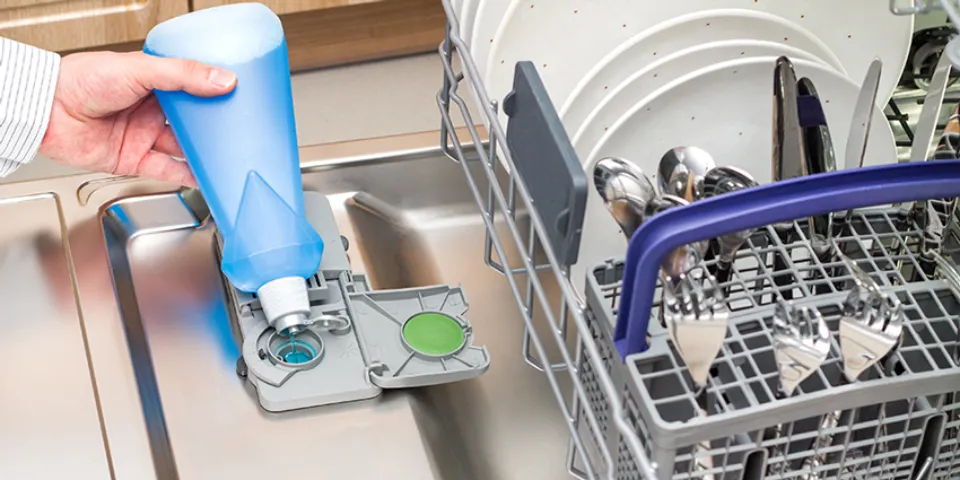
How Does Rinse Aid Work?
The components in rinse aids are intended to lessen the surface tension of the water used in the cleaning process of your dishwasher. How does this approach work so well? It all comes down to how water condenses and gathers scientifically. Water droplets lay flat instead of forming rounded beads when the surface tension is reduced. As a result, the water’s surface is exposed to more air, drying and draining more effectively. Since water doesn’t sit on your dishes as long, there are fewer spots, films, and residual markings on your glasses and dishware.
Suggested reading: How long do dishwashers last? This guide will tell you how to prolong the life of your dishwasher and keep it in good working condition.
What Will Happen If I Don’t Use a Rinse Aid?
Even though the consequences of not using regular rinse aid in your dishwasher are probably not disastrous, it can still have a noticeable effect on the effectiveness of your dishwashing cycles and the long-term appearance of your dishes. The heat from the dishwasher’s dry cycle will still help your dishes dry even if you don’t use rinse aid during dishwashing cycles. But if water sits on each dish for too long, you might get water stains. On fine china and pricey, high-quality glassware, this can be especially noticeable (and disastrous). Glasses will appear less clean, sparkly, and shiny in the short term. Failure to use rinse aid can eventually lead to permanent scratching, marking, and etching. Don’t take any chances; use rinse aid to ensure the best safety and effectiveness when washing your most valuable dishes.
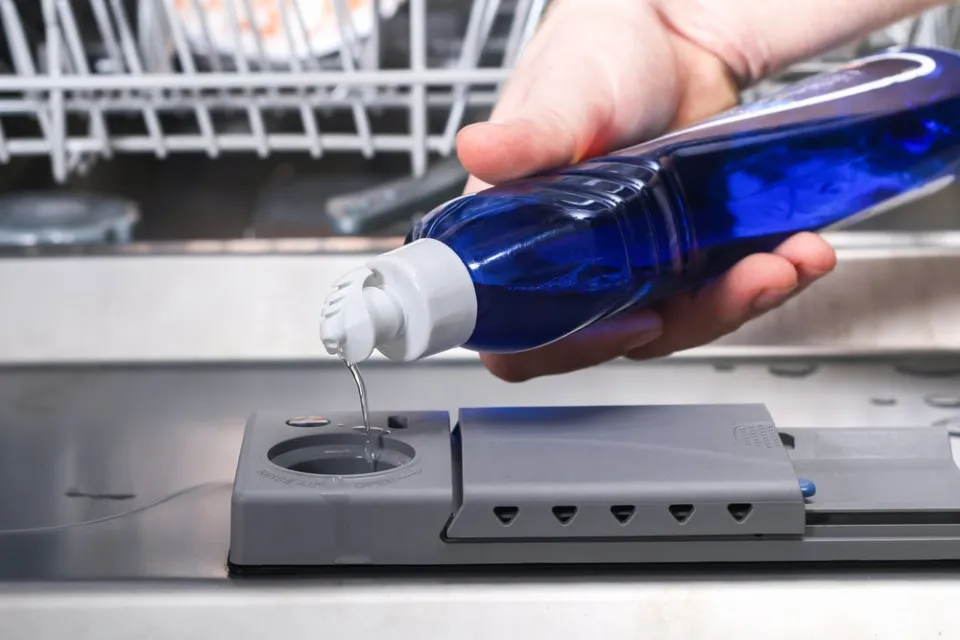
How to Use Dishwasher Rinse Aid?
The following are instructions on how to use rinse aid with two different dispenser styles on Maytag brand dishwashers—exact instructions may vary based on make and model. Remember that you might be able to control how much rinse aid is released during the last rinse. Verify the factory setting; it might be 2 or 3. Try a higher setting if your dishes are not drying properly, have rings, or have calcium (hard water) stains. More rinse aid will be released as a result, and the drying power will also increase.
Dispenser Style 1
STEP 1: OPEN THE DISHWASHER
A full opening of the dishwasher door should be observed. Turn the dispenser knob to “Open” or “Refill” and lift it out.
STEP 2: FILL THE DISPENSER
Pour rinse aid into the opening until the indicator points to “Full.” Be cautious not to overfill. Use a damp cloth to wipe up any spilled rinse aid.
STEP 3: CLOSE THE DISPENSER
Place the knob back into the opening and turn it to the “Lock” position. When the rinse aid indicator drops to the “Add” level, add more rinse aid.
Here is a video on how to add rinse aid:
TO ADJUST THE SETTING
Take the dispenser knob off. By using your fingers or by inserting a flat-blade screwdriver into the center of the arrow and turning, you can adjust the arrow adjuster inside the dispenser to the desired setting. Switch out the dispenser knob.
Dispenser Style 2
STEP 1: OPEN THE DISHWASHER
A full opening of the dishwasher door should be observed. By gently pressing with your thumb in the lid’s center and pulling up on the edge, you can open the rinse aid dispenser’s lid.
STEP 2: FILL THE DISPENSER
Pour rinse aid into the opening until the indicator points to “Full.” Don’t fill it too high. Any spilled rinse aid should be cleaned up with a damp cloth.
STEP 3: CLOSE THE DISPENSER
Gently press the lid down to close the dispenser. When the rinse aid indicator drops to the “Add” level, add more rinse aid.
TO ADJUST THE SETTING
With your thumb, gently push in the lid’s middle and pull up on the edge to open the rinse aid dispenser’s lid. Set the desired setting on the arrow adjuster located under the dispenser lid. Gently press down on the lid to close the dispenser.
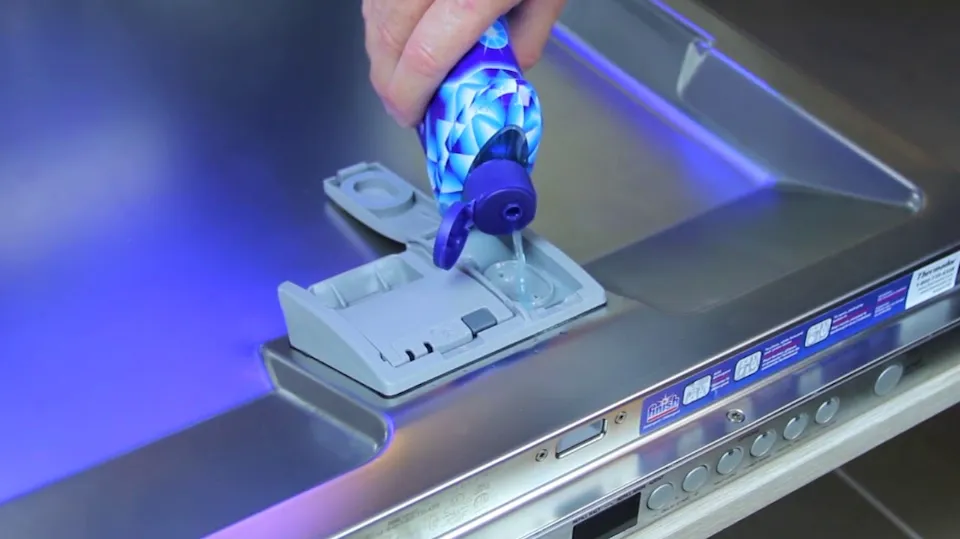
Do You Even Need It?
White vinegar is recommended by many DIY experts, but while it might cause your china to corrode, it can also harm your dishwasher, especially any rubber components in the rinse-aid cavity because of its high acidity. The truth is that, depending on your water’s mineral composition (and preferences), you might not even need rinse aid. Simply skip it if you don’t notice any water stains and your dishwasher appears to be drying your dishes effectively. This results in one less item to purchase, one less bottle to manufacture and ship, and a significant reduction in the exposure of aquatic life to substances classified as toxic by the EPA. Additionally, your food will come into contact with fewer dubious chemicals.
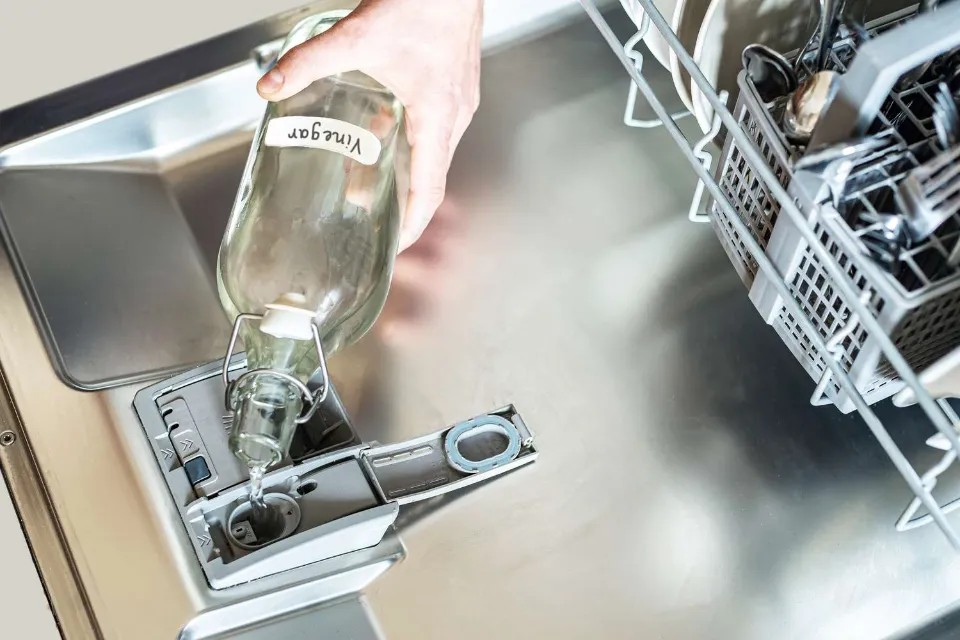
FAQs
Is It Necessary to Use Rinse Aid in the Dishwasher?
In order to achieve the best results, rinse aid is typically advised. Rinse aid improves drying efficiency and can lessen filming and water spots. Without it, the interior of your dishwasher and dishes might be overly moist. Also more effective with rinse aid is the heat-dry option. Even if you use dishwasher detergent packets, rinse aid can still be beneficial.
How Often Should I Use Rinse Aid in My Dishwasher?
Depending on how often the dishwasher is used, a full dispenser should hold 5 oz (150–175 mL) of rinse aid and last for about a month. The final rinse cycle involves an automatic dispensing of about 3 milliliters (less than ½ teaspoon). The level in the gauge can be checked more easily with colored rinse aid.
What Can I Use Instead of Dishwasher Rinse Aid?
Just fill the rinse aid dispenser with a little white vinegar, or if you don’t have a rinse aid dispenser just put a cup filled with vinegar upright in the bottom rack when you run the wash.
Another Reason to Use a Rinse Aid?
It makes your dishes dry faster, which is helpful if you’re skipping the heat cycle to save energy, or if you notice that your dishes are still wet when your heat cycle finishes. On the other hand, if your dishwasher is producing good results, you might not need a rinse aid.
Summary: What is Dishwasher Rinse Aid?
A drying agent called rinse aid helps reduce water spots on dishes and enhance dishwasher drying performance. Just once every few washes does it need to be refilled. There are numerous all-in-one detergent packs that include small amounts of rinse aid, but you should still use regular liquid rinse aid.
If you have any questions, please leave a comment. My Prime Home tries to give you the best home improvement information. Don’t forget to share the post. Thank you for reading.
You may want to know:
